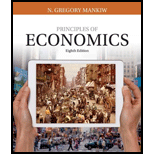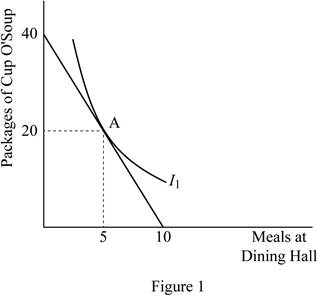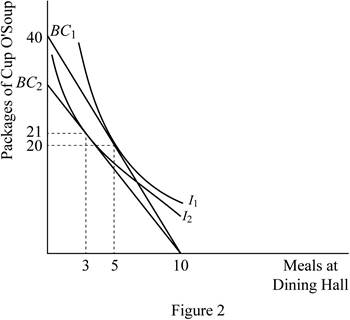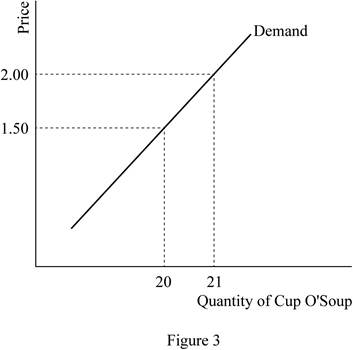
Concept explainers
Subpart (a):
The budget constraint and trade-off.
Subpart (a):
Explanation of Solution
When the wants and needs of a human are unlimited and the budget of an individual is limited, it will lead to a constraint of needs and this constraint raised is due to the limited budget is known as the budget constraint of an individual. Thus, the budget constraint is defined as the possible combination of goods and services that is purchased at a given
Here, the income of the person is given as $60, the price of one meal at dining hall is $6, and the price of cup 'o soup is $1.5. Thus, when the consumer spends her entire income on the meal in dining hall, the quantity that she receives can be calculated by dividing the income by the per meal price as follows:
Thus, when she spends all her income on meal from dining hall, she can buy 10 meals. When she spends all her income on the cup 'o soup meal, the quantity can be calculated by replacing the price of dining hall meal with that of cup 'o soup as follows:
Thus, when she spends all her income on the cup 'o soup meals, she can receive 40 cup 'o soup meals.
The budget constraint represents all the combinations of these two goods ranging between 10 dining hall meals and no cup 'o soup meal to no dining hall meals and 40 cup 'o soup meals. However in this case, the consumer spends her income equally on both of the commodities. Thus, she spends $30 each on dining hall meals and cup 'o soup meals. Thus, when the consumer spends $30 on the meal in dining hall, the quantity that she receives can be calculated by dividing the income by per meal price as follows:
Thus, when she spends $30 of her income on meal from dining hall, she can buy 5 meals. When she spends $30 of her income on the cup 'o soup meal, the quantity can be calculated by replacing the price of dining hall meal with that of cup 'o soup as follows:
Thus, when she spends $30 of her income on the cup 'o soup meals, she can receive 20 cup 'o soup meals. This will be the point of her consumption, when the income is equally spent on both commodities. The graphical representation shows this combination at point A and it is represented as follows:

Concept introduction:
Budget constraint: Budget constraint is defined as the possible combination of goods and services that is purchased at a given price level with the entire income.
Normal good: The goods whose quantity demanded increases, when the income of the consumer increases and vice versa.
Inferior good: The goods whose quantity demanded falls, when the income of the consumer increases and vice versa.
Giffen goods: They are the special cases of inferior goods in which an income effect overweighs the substitution effect.
Subpart (b):
The budget constraint and trade-off.
Subpart (b):
Explanation of Solution
When the price of the cup o' soup increases to $2 from $1.5, the vertical intercept of the student's budget constraint will shift downwards; this will flatten the budget constraint curve. When she spends all her income on the cup 'o soup meal, the quantity can be calculated by replacing the price of dining hall meal with that of cup 'o soup as follows:
Thus, when she spends all her income on the cup 'o soup meals, she can only receive 30 cup 'o soup meals. This flattens the budget constraint curve.
It is also said that at present she only spends 30 percent of her income on the dining hall meal, which means that the income spent on dining hall meal is only $18 and that spend on cup o' soup is $42. At this income spending distribution, she can purchase 3 units of dining hall meals and 21 units of cup o' soup meals. This new point can be illustrated as point B and it can be represented as follows:

Concept introduction:
Budget constraint: Budget constraint is defined as the possible combination of goods and services that is purchased at a given price level with the entire income.
Normal good: The goods whose quantity demanded increases, when the income of the consumer increases and vice versa.
Inferior good: The goods whose quantity demanded falls, when the income of the consumer increases and vice versa.
Giffen goods: They are the special cases of inferior goods in which an income effect overweighs the substitution effect.
Subpart (c):
The budget constraint and trade-off.
Subpart (c):
Explanation of Solution
The initial price of cup o' soup was $1.5, and the new price after the increase is $2. The initial quantity demanded of cup o' soup was 20 units; whereas after the increased price of the commodity, the quantity demanded is 21 units. This shows that the
Concept introduction:
Budget constraint: Budget constraint is defined as the possible combination of goods and services that is purchased at a given price level with the entire income.
Normal good: The goods whose quantity demanded increases, when the income of the consumer increases and vice versa.
Inferior good: The goods whose quantity demanded falls, when the income of the consumer increases and vice versa.
Giffen goods: They are the special cases of inferior goods in which an income effect overweighs the substitution effect.
Subpart (d):
The budget constraint and trade-off.
Subpart (d):
Explanation of Solution
The initial price of cup o' soup was $1.5, and the new price after the increase is $2. The initial quantity demanded of cup o' soup was 20 units denoted by point A; whereas after the increased price of the commodity, the quantity demanded is 21 units denoted by point B. This shows that the demand for the commodity will increase, when the price of the commodity increases. Thus, these two points can be graphically illustrated as follows:

Here, the demand for the cup o' soup increases, when its price increases, which means that the commodity is an inferior good. However at the same time, the income effect overweighs the substitution effect for the commodity, which is a special case of inferior goods, known as the Giffen goods. Thus, the cup o' soup is a Giffen good.
Concept introduction:
Budget constraint: Budget constraint is defined as the possible combination of goods and services that is purchased at a given price level with the entire income.
Normal good: The goods whose quantity demanded increases, when the income of the consumer increases and vice versa.
Inferior good: The goods whose quantity demanded falls, when the income of the consumer increases and vice versa.
Giffen goods: They are the special cases of inferior goods in which an income effect overweighs the substitution effect.
Want to see more full solutions like this?
Chapter 21 Solutions
Principles of Economics (MindTap Course List)
- Use a game tree to illustrate why an aircraft manufacturer may price below the current marginal cost in the short run if it has a steep learning curve. (Hint: Show that learning by doing lowers its cost in the second period.) Part 2 Assume for simplicity the game tree is illustrated in the figure to the right. Pricing below marginal cost reduces profits but gives the incumbent a cost advantage over potential rivals. What is the subgame perfect Nash equilibrium?arrow_forwardAnswerarrow_forwardM” method Given the following model, solve by the method of “M”. (see image)arrow_forward
- As indicated in the attached image, U.S. earnings for high- and low-skill workers as measured by educational attainment began diverging in the 1980s. The remaining questions in this problem set use the model for the labor market developed in class to walk through potential explanations for this trend. 1. Assume that there are just two types of workers, low- and high-skill. As a result, there are two labor markets: supply and demand for low-skill workers and supply and demand for high-skill workers. Using two carefully drawn labor-market figures, show that an increase in the demand for high skill workers can explain an increase in the relative wage of high-skill workers. 2. Using the same assumptions as in the previous question, use two carefully drawn labor-market figures to show that an increase in the supply of low-skill workers can explain an increase in the relative wage of high-skill workers.arrow_forwardPublished in 1980, the book Free to Choose discusses how economists Milton Friedman and Rose Friedman proposed a one-sided view of the benefits of a voucher system. However, there are other economists who disagree about the potential effects of a voucher system.arrow_forwardThe following diagram illustrates the demand and marginal revenue curves facing a monopoly in an industry with no economies or diseconomies of scale. In the short and long run, MC = ATC. a. Calculate the values of profit, consumer surplus, and deadweight loss, and illustrate these on the graph. b. Repeat the calculations in part a, but now assume the monopoly is able to practice perfect price discrimination.arrow_forward
 Economics (MindTap Course List)EconomicsISBN:9781337617383Author:Roger A. ArnoldPublisher:Cengage Learning
Economics (MindTap Course List)EconomicsISBN:9781337617383Author:Roger A. ArnoldPublisher:Cengage Learning


 Exploring EconomicsEconomicsISBN:9781544336329Author:Robert L. SextonPublisher:SAGE Publications, Inc
Exploring EconomicsEconomicsISBN:9781544336329Author:Robert L. SextonPublisher:SAGE Publications, Inc Principles of MicroeconomicsEconomicsISBN:9781305156050Author:N. Gregory MankiwPublisher:Cengage Learning
Principles of MicroeconomicsEconomicsISBN:9781305156050Author:N. Gregory MankiwPublisher:Cengage Learning





